
via la_biennale
So Venice is not a total bust. Raumlaborberlin have installed their 2006 mobile inflatospace sculpture, „Das Küchenmonument,” in the Giardini.
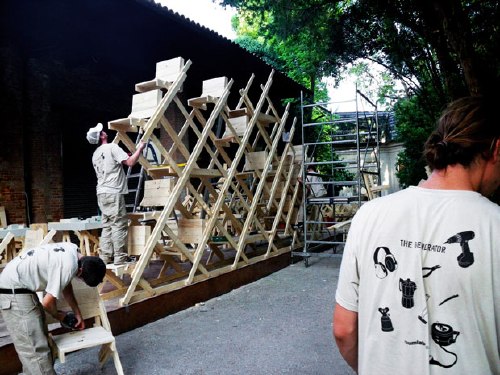
And next to it is The Generator, an on-site workshop for knocking together “sedia veneziana,” which are not just autoprogettazione-style chairs…
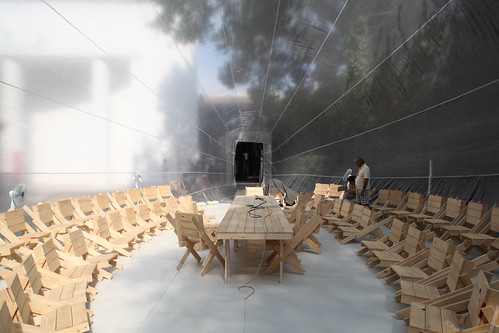
via br1dotcom
they’re “future particles of the generator-space-structure,” modular building elements of both social space and structure. autoprogettazione stacking chairs. Awesome.
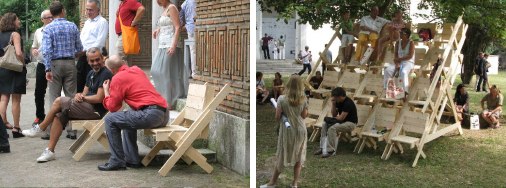
Which, of course, is related to their exhibition for Arc en Reve in Bordeaux last year, “Chaise Bordelaise.”

“Chaise Bordelaise” consisted of a 3x3x1m pile of pre-cut, reclaimed lumber, instructions, and some tools. Visitors made some chaises, then took them home.
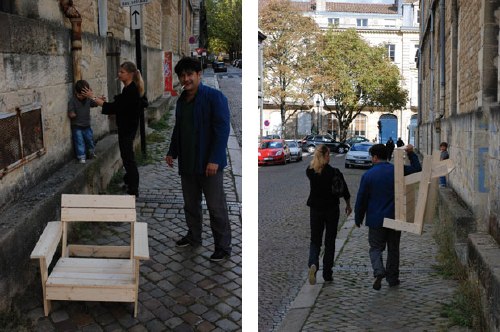
It’s basically an Enzo Mari x Felix Gonzalez-Torres mashup. If greg.org had tags, this post would be giving me a tagasm right now.
Raumlaborberlin: what’s up? exhibitions [raumlabor.net via archinect]
Chaise Bordelaise [raumlabor.net]
related: proposta per un’ auraprogettazione
Venetian Mirror
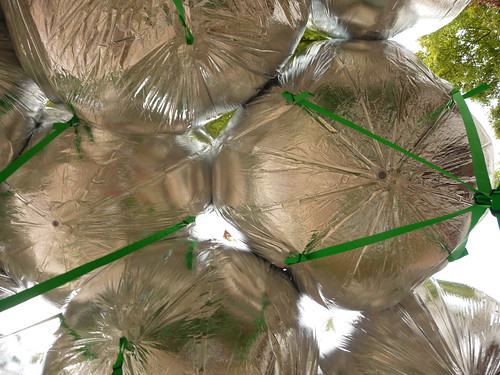
via tsaaby
Yeah, so I’d been poking around flickr for a while, looking to see how MOS’s project for the US Pavilion at the Venice Architecture Biennale turned out. Because well, because.

via Erika-Milite
And hmm. What is it about it? The green straps? Should the weather balloons have been upside-down, so gnarly knots and straps take a backseat, and the smoother, more reflective surface is visible instead of pointing to the sky? Maybe instead of straps, string a net across the courtyard, and attach the balloons from above, or maybe let the balloons float up against it to find their own structure?
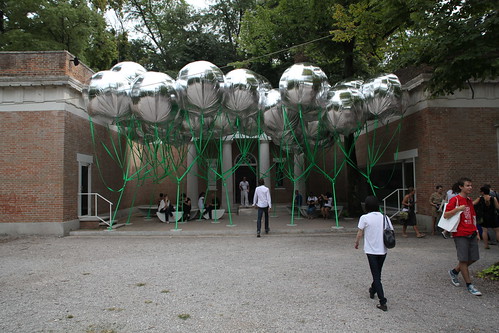
via
br1dotcom
Do the balloons just not have enough gas, or enough gores?
Because right now, I’m rethinking my entire satelloony look.
It’s Reagan Men! Hallelujah!
This is where Nightcrawler ‘ports in and shouts, “Ausgezeichnet!”
Here is Joseph Beuys, pop singer, performing his greatest anti-US, anti-nuclear hit from 1982, “Sonne statt Reagan, [Sun not Reagan].” Reagan, remember, is a German homonym for rain [Regen], so it makes perfect sense.
As Ubu explains it, “Beuys tried his luck as a pop singer as part of his political commitment.” Sure.
To throw one more tidbit in there, here’s one section of the lyrics that jumped out at me:
Er sagt als Präsident von USA
Atomkrieg ? – Ja bitte dort und da
ob Polen, Mittler Osten, Nicaragua
er will den Endsieg, das ist doch klar.
He says as President of USA
Nuclear war? – Yes please here and there
whether Poland, Middle East, Nicaragua
he wants the final victory, that much is clear.
Endsieg: perhaps Reagan used a loaded term in German, one that turns out to be associated with Jews in Mein Kampf and inevitable civilian casualties in the Third Reich. But translation can be a bitch that way. Just ask the guy who came up with “enhanced interrogation” [“Verschärfte Vernehmung”].
Thanks greg.org reader frank for the felt hat tip.
MoMA On Fire
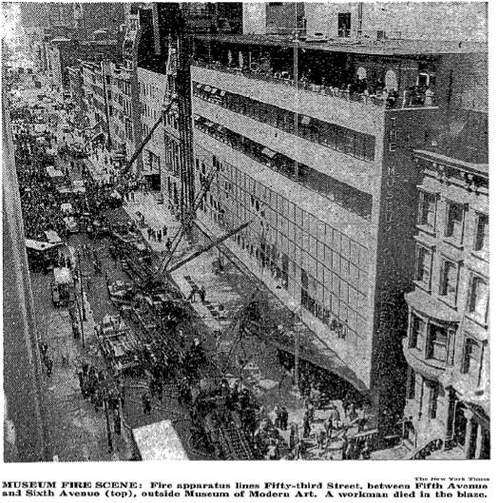
The fire at the Phillips Collection in Washington DC this morning reminded me of the incredible story of another museum fire, at The Museum of Modern Art in 1958. Before my time, I know, but I’d only learned of it last year, when Ann Temkin staged a show of Monet’s Water Lilies [Here’s Roberta Smith’s review, and a tangent I went on about Pollock] and mentioned the fire.
Mentioned the fire because it destroyed a giant, 18-foot-long Water Lilies painting the Museum had acquired just a couple of years before. [The current 3-panel Water Lilies was the replacement.]
UPDATE: LIFE published a 2-page color spread of the painting with the announcement of The Modern’s acquisition in 1957:
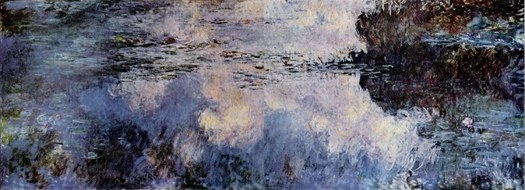
So what happened? The New York TImes’ report from the scene [purchase required] is riveting. [one image above] Director Rene d’Harnoncourt “trudging out” onto the street in tears. One worker dead, two visitors injured, and dozens of firefighters treated for smoke inhalation. Visitors and staff trapped on the penthouse terrace being evacuated by Alfred Barr, who throws a chair through a window and catches women and children on the roof of the neighboring townhouse. The fire chief marveling “at how women employees, soaked by dripping water, kept helping save the pictures.”
Like the Phillips fire [apparently], the MoMA fire was triggered by construction. In the Modern’s case, contractors installing air conditioning on the second floor were smoking near open paint cans, sawdust, and a canvas dropcloth. The work meant that except for the largest paintings, all the other art had been cleared from the second floor.
Art on the third and fourth floors was undamaged, and was evacuated to the garden, and to the Whitney Museum, which abutted MoMA on 54th St. Among those works? Hello, Seurat’s Sunday Afternoon on the Island of La Grande Jatte, which was on its one and only loan from the Art Institute of Chicago. Close call.
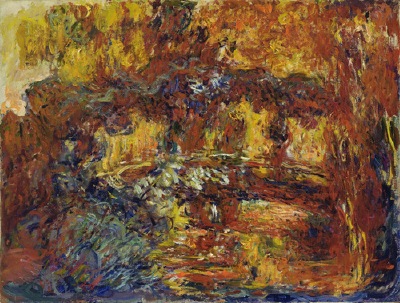
Meanwhile, besides the Monets–the large Water Lilies was apparently hanging on the 53rd St wall and had been “hacked” fighting the fire–the Museum initially reported that four works had been damaged or lost. The other Monet, another, smaller, late work hanging in the Bauhaus Staircase, was supposedly restorable, despite, as the Times put it, having “its oil flowed and blistered,” and “looking like a toasted marshmallow.” I guess I’ll have to check, but the Giverny painting known as The Japanese Footbridge [above] came into the collection in 1956, so unless MoMA had three late Monets at the time, that’s the toasted one.
[UPDATE: They did. Temkin’s essay about the Water Lilies makes it clear that the stairway painting was a smaller, but still big, Water Lilies. The Museum tried for three years to restore it, but in 1961, it was declared to be damaged beyond repair. Jackson Pollock’s No 1A, 1948. was also in the staircase and also damaged, but it was conserved.
Of the fate of the largest Water Lilies, Temkin wrote, “After the fire, Museum officials returned to find the painting buried under a pile of debris on the ground; firefighters had unknowingly destroyed it breaking through the windows into the building.” There’s a photo of the aftermath in LIFE Magazine’s April 28, 1958 issue. It is unreal.]
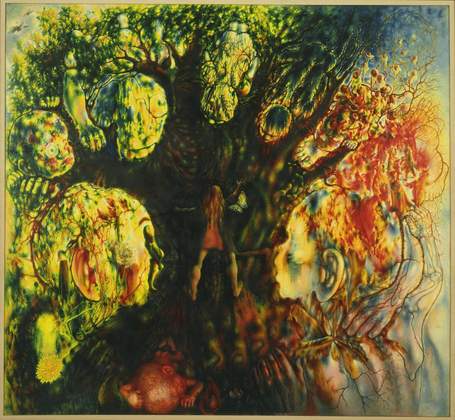
Boccioni’s The City Rises is still around, as is Pawel Tchelitchew’s Cache-cache [Hide and Seek], which was described as “probably the most popular [painting] in the museum.” [More on that in a second. The controversial original 1953 version of Larry Rivers’ Washington Crossing The Delaware [below] was damaged, though for some reason, it’s not listed in MoMA’s collection. Which means the only other total loss besides Water Lilies was a World’s Fair mural by the Brazilian artist Candido Portinari.
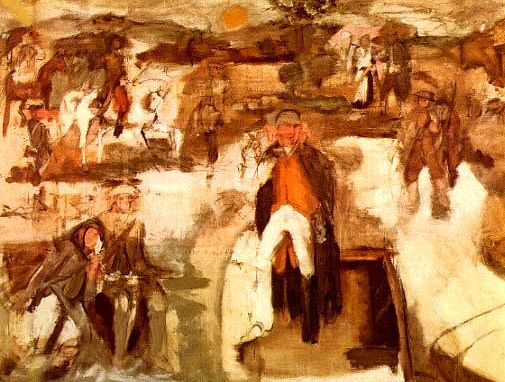
In a Times sidebar on April 16 detailing the art losses, Sanka Knox was reassured by a Museum “spokesman” that “none of the damaged pictures, including the two Monets, are among the most valuable of the museum’s paintings,” and then an unnamed “staff member” said that, “apparently none of the museum’s most valuable holdings” were damaged.” Which begs the question, right? Right:
Among these “most valuable” works, according to a staff ember, are Rousseau’s The Dream, Picasso’s Three Musicians, Van Gogh’s The Starry Night and Gaugin’s Still Life with Three Puppies.”
I’m sure it means nothing, but the only museum official quoted by name in Knox’s piece was Barr himself. Now about that most-popular Tchelitchew.
In 2007 FIT art history professor Richard Turnbull gave a Brown Bag Lecture at the Museum about the divergence of curatorial and popular opinion titled, “From Pavel Tchelitchew’s Hide-and-Seek to Andrew Wyeth’s Christina’s World” [mp3 available]. He said the museum education staff gets asked about Hide-and-Seek all the time by teachers; apparently it’s been in the NYC public school curriculum for decades, and they always want to walk kids through the painting’s cycle of life allegories. [Actually, I just finished listening to the whole lecture; it’s more like Tchelitchew hid so many faces and figures in the painting, you can stare at it for hours. It’s like a psychosurrealist Where’s Waldo?] It hasn’t been on view since around 1999 when the Museum closed for renovations.
Is it just me, or do all these paintings still look burnt? What a palette.
[images: top, nyt; the rest: moma.org]
Thomas Houseago Speaking At The New School
It’s taking me a while to warm to Tom Houseago’s sculptures, but that’s fine. It took me a very long time to come around to Rachel Harrison’s work, and boy, is it worth it, so I’m happy to give it time.
Meanwhile, this long, impassioned, fascinating, and quite awesome speech he gave at The New School in May as part of his Public Art Fund group exhibition, “Statuesque” [which is up right now, and which just got a too-condescending review in the Times, and which Andrew Russeth just posted a nice commentary about] is worth every one of its ninety-plus minutes.
Talking about him leaving his studio in Belgium? His heartfelt shoutout to the Rubells who, really, wow. Give them grief if you want, but they are some of the most dedicated, hardcore lookers and supporters of artists around, and they continue to be. Also, Leeds football hooligans and Star Wars and late Picasso and bongs for babies? Houseago makes a crazy/infectiously compelling case for his work, and for art itself.
Great stuff that should be seen by more than the 338 YouTube viewers and the 250 people in the New School auditorium who’ve seen it so far.
Don’t Hang Up, Just Talk About It!
The Ed-werd Rew-Shay Memorial Art World Pronunciation Guide keeps on growing!
the latest additions include:
Richard Anuszkiewicz
Huma Bhabha
Thomas Houseago
And some great mispronunciations that needed addressing:
Chinati
Laocoon
Modigliani
Also, I just know the Aperture Foundation’s video editors are totally taunting me by leaving the introduction off their 4-part interview between Okwui Enwezor and Zwelethu Mthethwa. [OAK-wee en-WAY-zore and Zweh-LAY-too m’TATE-wah, I know, but it’s such a tantalizing two-fer.]
Have any suggestions, stumpers, or maybe some great mispronunciations you’ve heard? Send them in!
If you see something, say something!
With All Due Respect To Bruno Bischofberger
this is pretty awesome:
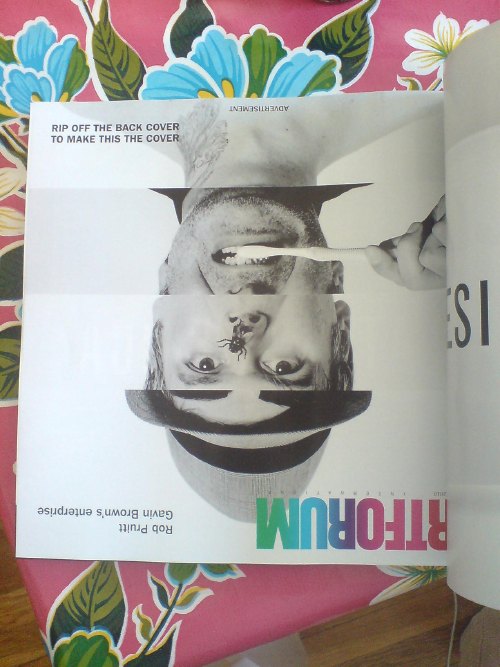
Do Daniel Libeskind’s Awesome Machines Mean I Have To Stop Hating His Work?
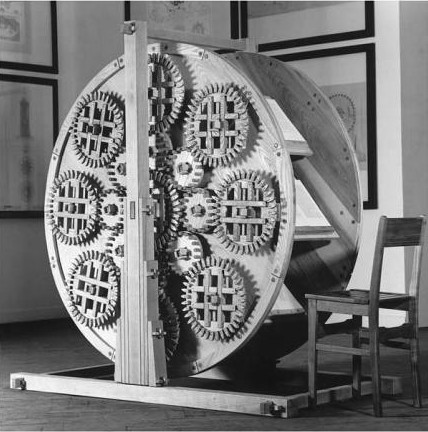
In the 1980s Daniel Libeskind was an increasingly prominent architectural theorist who–I was about to say “who had nevertheless not actually ever built anything,” but the whole thing that’s turning my head upside down is that he did, in fact, build something in the 80s: these machines.
They were exhibited at the 1985 Venice Architecture Biennale as “Three Lessons of Architecture.” There’s The Reading Machine, The Memory Machine, and The Writing Machine, all intended as metaphors concerning the then-hotly debated post-structuralist theory of architecture-as-text.
Because I haven’t sprung for any Libeskind monographs where he discusses the project, for my understanding I rely heavily on Lebbeus Wood’s thoughtful blog post, which also happens to be full of beautiful photos of these incredible machines:
the vogue for a linguistic interpretation of architecture has passed, and the avant-garde has moved on, or at least elsewhere. Libeskind’s machines, inspired by reading and writing and implicitly interpreting texts, as well as memory (treated as text), would be of little interest today if the machines were only didactic illustrations of theory. But they are much more. As objects of design, they have powerful presence, as well as conveying a refined and highly rigorous aesthetic sensibility. As acts of the disciplined imagination of tectonic possibilities–how many parts might be assembled into a compelling whole–they are highly original, exemplary, and instructive. For example, in the diverse, even contrasting ways the same material, such as wood, can be used expressively in the same construction. Or, in the complexity of joints, from fixed to flexible, enabling the total assemblage. Of course, as hand-crafted constructions (a bit too ‘Renaissance’ for comfort, as was Tatlin’s Flying Machine), they are at once nostalgic and visionary, the latter if we believe that technology is not the main issue at stake in architecture
The ‘Renaissance’ feeling is not off the mark, and by design. To make his argument for the end of humanist architectural history and for a reincarnation of sorts for [his] universe of architectural reference points, Libeskind went way back, both in terms of design and technology, using period technique to build important unrealized machines from history.
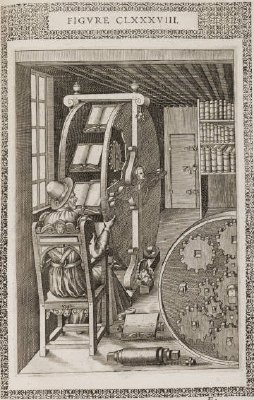
The Reading Machine, for example, is a fabrication of the “Reading Wheel” published in 1588 by Agostino Ramelli in his enormously influential engineering and design folio, Le diverse et artificiose machine del capitano Agostino Ramelli. It was designed to let a scholar keep his place while moving from tome to tome, a giant, creaking set of browser tabs. In a paper on “Three Lessons” presented in 2007, Ersi Iannidou [pdf] describes the making of:
Libeskind, determined to retrieve the experience of constructing such a machine, chooses to recreate not only the object, but also the experience. He works as a craftsman, bearing total faith in the craft of making. He builds it with hand-tools, solely from wood, with glue-less joints, dawn to dusk, in complete silence. When finished, he makes eight books–he writes them, makes the paper, binds them; just one each–and places them on the wheel. Each book contains just one word or phrase repeated anagrammatically: idea, spirit, subject, power, will to power, energia, being, created being…[it represents] ‘the triumph of the spirit over matter, of candlelight over darkness’. It teaches an ‘almost forgotten process of building’, namely, handicraft.

The Memory Machine is Libeskind’s interpretation of Giulio Camillo’s “Memory Theatre,” a 16th-century structure where, upon entering, a person’s mind would be filled and inscribed with a knowledge of the universe. Some historians have argued that Camillo’s idea influenced the construction of Shakespeare’s Globe Theatre, which may or may not have been why Libeskind based his design on a period stage set apparatus.
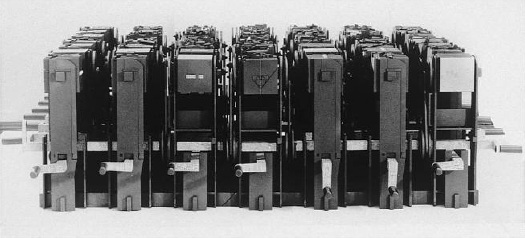
He makes a leap to modernity with The Reading Machine, which is an interpretation of Raymond Roussel’s “Reading Machine.” 49 square columns were rotated in impossible-to-follow ways by a series of handles, signaling the removal of the human architect from the industrialized city. Libeskind has since waxed, as he does, spiritually about the piece,
…which was designed to generate a new understanding of the ever-living city. This construction, a veritable spiritual experiment, involved reincarnating an experience of a medieval ascetic world, by constructing a machine in a monastic way, using no modern equipment, no electricity, but the discipline of craft, candlelight and the power of faith in the future text of architecture. The machine dealt with the organized chaos in which permutations of names of saints, both true and apocryphal, emblems, reflections and cities were symbolically and physically made mobile by turning the ‘circle into square’. It took twenty eight simultaneous rotations to turn the machine’s faces toward the unexpected image of a reawakened site.

Mhmm. Ioannidou quotes Libeskind as calling The Writing Machine “a quadripartite computer operation,” which begins to hint at at least one reference that I can’t find anybody making: to the difference engines of Charles Babbage, which were the early 19th century, mechanical ancestors of computers. Keep that in mind while reading Libeskind-via-Ioannidou again on the making of:
The Writing Machine is an industrial apparatus; so the architect becomes an industrialist, architecture a nine-to-five job. For the construction of this last machine Libeskind sets up a business, buys a clock, and focuses on the bare minimum of technique. He works hard–nine to five at the start, later overtime–speaks ‘small talk’, smokes cigarettes, does not mingle work with other issues–especially having fun.
I think we are to understand here that Libeskind not only built these things, but that he built them in deeply meaningful, experiential ways. They’re the not just by-products of his Method Architectural Theory, but its literalization. The Architectural Word Made Flesh. Or wood, as the case may be, but still.
As a guy contemplating the historically accurate bricolage-style refabrication of, among other things, a 1960 satelloon, I can appreciate all this seemingly conceptual performativity. Well, some of it. The part that isn’t a Renn Faire version of the Woodwright’s Shoppe. But the bigger problem for me is I’m not sure I like where this is heading.
Read Woods’ description of the seemingly unintended architectural consequences of post-structuralism’s decoupling of form and function and tell me that it doesn’t ft Libeskind’s disastrously clichéd building projects to a T:
What began as a radical concept affecting the very core of architecture, is compromised, we might say reduced, to commercially marketable and client-acceptable styles–a fate much the same as idealistic modernism suffered in its time.
So knowing what we know now, and faced with a worldwide blight of Crystalline Shard™ museum annexes and condos, can we see the warning signs of Libeskind’s epic failure in these machines? Are there other lessons to be learned from “Three Lessons”? Should I not let myself like these fantastical contraptions quite so much?
I don’t know yet. But it reminds me of the takeaway from 1939: The Lost World of the Fair, the book David Gelernter wrote while recovering from being attacked by the Unabomber, how we basically ended up with the future we were promised at the World Fair–including TV and car-based suburban sprawl–and it sucks.
On a more practical note, I’ve tried to find out more about the actual making of Libeskind’s machines, and to figure out where they are now. But since Libeskind’s studio only responds to “credentialed media,” I’m left to assume that all three machines met the fate of The Writing Machine, which Libeskind says was destroyed in a fire at the Palais des Nations Palais Wilson in Geneva in 1987. Too bad, because at the rate he’s going, they were the best things he ever built.
The Trendmaking Eye
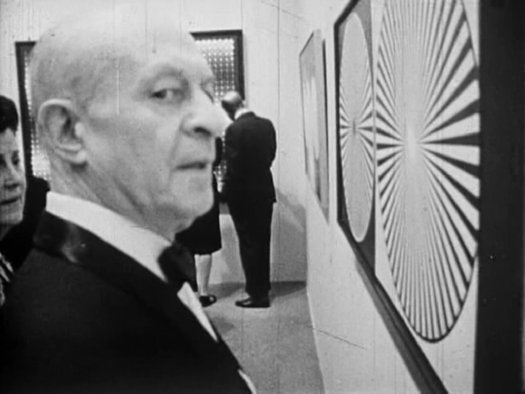
One of the great stories surrounding MoMA’s 1965 exhibition “The Responsive Eye” is how collector/garmento Larry Aldrich turned several Op paintings he owned into fabrics, and then into dresses, which fed into the Op Art Trend that was apparently swirling around New York. Of course, it’s a great story if you’re not named Bridget Riley.
It’s a well-known story, partly because Aldrich had invited a Herald Tribune columnist and photographer to his showroom to meet Riley who, until that moment, had no idea about the project. And she. Was. Pissed. Riley reportedly tried to sue, and differing accounts say she was either successful or thwarted by US laws. The line was either a raging, lucrative success on the artist’s back, or a failure, because a million other Op Art designs instantly saturated the market.
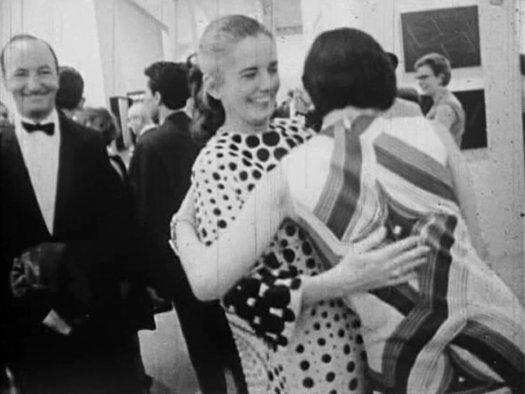
But that’s jumping ahead. Let’s let Aldrich set it up with his rambling, entertaining, and humiliating side of the story, as told to Paul Cummings in a 1972 Archives of American Art interview:
LA: I showed Bill all of those paintings that I thought were a new form of geometries, and I believe that he picked out two of them for the Observant [sic] Eye show that he did not know about. One was an Avedisian and the other one whose name we can’t remember at the moment — It was at the Martha Jackson Gallery. But when we were in our cutting room, he said, “You know, Larry, really I think it would be a terrific idea if you were to convert some of these to fabric.” I had a less expensive firm as well as the Larry Aldrich clothes called Young Elegants, and I got Julian Tomchin who was a fabric designer. I had the Vasareley and the Bridget Riley and Anuszkiewicz and this other young man who I can’t remember [Julian Stanczak] were fine with it. But then, and I said I would like to convert these into prints. I said I don’t want them to be copies of these paintings, but I want the prints to be inspired by these paintings. Of course this is something that you’re going to have to do exclusively for me. And so he presented quite a number of sketches for this line. And then he made up the fabric. I stress again that he was to make these exclusively for me, but he was a very clever little boy, for while he made those exclusively for me he made variations on those and put them on an inexpensive fabric that was shown and sold to inexpensive blouse people and what not.
PC: So they were everywhere?
LA: They were everywhere all of a sudden. Anyhow, the Bridget Riley one was not necessarily the most successful, but because it was interpreted in black and white and in grey and white, it was quite effective. And Bill said, “I think it would be wonderful if you gave Irma [his wife] a cut of the fabric, and she could have a dress made out it to wear to the opening of the Observant Eye show.” And a turban. I sent her a big swatch of it. In the meantime, we had designed some dresses, and I showed them to Life magazine. And Life went for them and had a feature that came out shortly after the Museum of Modern Art show opening. Anyhow, Anuszkiewicz, whom I had gotten to know quite well by then, was just thrilled with the idea of what I had done. This other chap at Martha Jackson’s Gallery [Stanczak] was very, very happy about it. The one that lived in Paris I didn’t hear from.
PC: You mean Vasarely?
LA: Vasarely, yes. Bridget Riley was coming for the show, and I met her at the opening dinner. In fact, this was such a big event that NBC or CBS were filming, and they asked that I be filmed with her in front of the Bridget Riley, which I had loaned for the show and [they had me] tell how I happened to buy it, you know, the whole story of seeing it in the Tate and so forth. And she was very attractive, and so I said, “Would you come down to my showroom? I have something that I’d like to give you as a gift.”
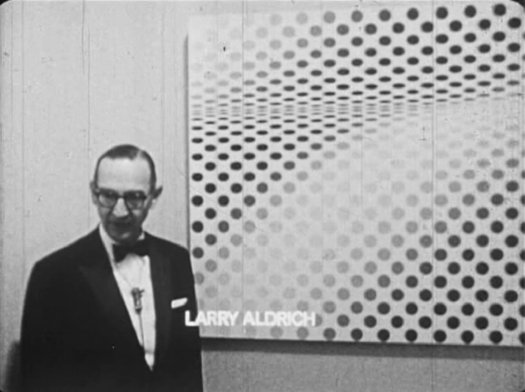
And that’s where the Herald Tribune picks up the story. Sure, we can be shocked, shocked that Aldrich just went ahead and did all this without asking the artists first. But then shouldn’t we also be amazed that Aldrich says the idea to turn the paintings into fabrics in the first place came from MoMA curator William Seitz?
That LIFE Magazine spread, by the way, is right here. Shot in the Modern’s show. I have to agree with Aldrich, the Riley print on the upper right is not that great.
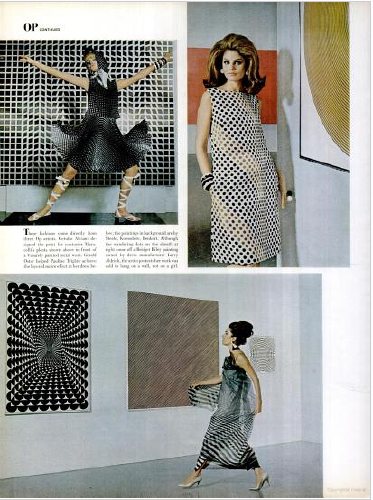
And while Aldrich is not doubt remembering Mike Wallace’s “Eye on New York” show about “The Responsive Eye,” that’s not who interviewed him at the opening. It was a 25-year-old film student from Sarah Lawrence named Brian de Palma, and his be-boa’ed 26-year-old producer Midge Mackenzie, who made a 20-minute documentary short called The Responsive Eye.
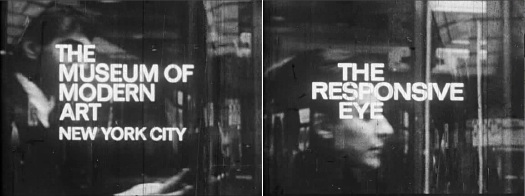
The filmmakers interviewed Seitz during installation, and then they had free access to film in the show’s black-tie opening. Since it’s dePalma, I did a split screen combining the opening titles because, really, make me think their film was commissioned by the Modern itself. There’s no mention of it in the Museum’s press archive, but in 1963, de Palma was presented with an under-25 award at the Museum by the Society of Cinematologists for his undergrad short Woton’s Wake. Somebody want to ask de Palma what the deal was?
In 1965 Riley complained that the “explosion of commercialism, band-wagoning and hysterical sensationalism” was obscuring the “serious qualities” of “The Responsive Eye.” And her collectors, the curators, and the Museum were right in the middle of it. As Bill Seitz said to Mike Wallace, “it’s really the absorption of modern art into modern life. And that’s something we all wanted, but, uh, it may change the character of the art a bit, too.”
Creative Time And The Afro-Icelandic Liberation Front

Danish artist Jacob Boeskov flew to Lagos, Nigeria to make and star in a short action film he wrote titled, Dr. Cruel and the Afro-Icelandic Liberation Front with the noted Nollywood director Teco Benson. The film was produced by Creative Time Global, a new series of international initiatives launched this year by the NY public art organization.
Nollywood is known for its vibrant, near-zero-budget film industry, which should probably be called a video feature industry, since HD, DV, and even phonecams are the norm, and everything goes straight to the street on DVD. Dr. Cruel premiered in May in New York, but Creative Time recently posted Boeskov’s production diary online:
It has been a long day and Teco has surely delivered. He really is the finest action director in Nollywood. We have filmed chases and fights. I have destroyed a pair of my pants in one of my amazing stunt moves. He has been great to work with. He has an ability to make actors and crew feel good, even when he shouts at them. But it is late now and everybody is tired.
Just as we’re wrapping up a scene, I hear the sound of a generator dying and the room goes black. The production manager runs down to the street to look for black market fuel. There is a fuel crisis in Nigeria because of the absence of the president and… well, it’s a long story.
I go to the window and light a cigarette. The room is dark, lit only by the cell phones from the actors and the crew. The mood in the room is intense, but okay, I guess. People talk low, or are silent. The production manager is back, looking triumphant. He has managed to buy some fuel in the street, and the generator is running again. The lights are turned on. Back to work.
It all sounds a little crazy, but interesting. Here’s the trailer:
Dr. Cruel and the Afro-Icelandic Liberation Front [creativetime.org via @annepasternak]
I Didn’t Know ‘What I Did On My Vacation’
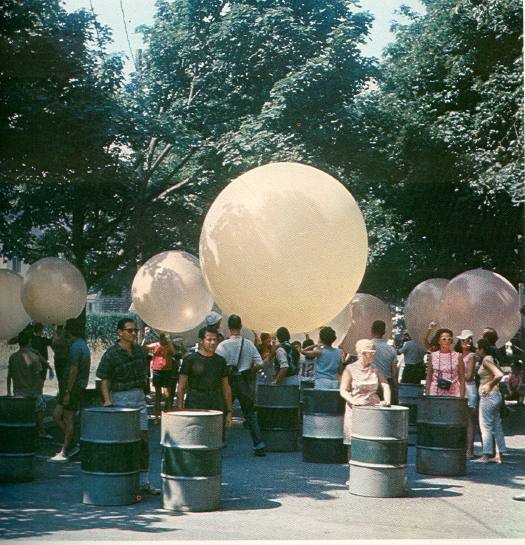
Holy smokes, Gordon Hyatt, I didn’t know what you did 44 summers ago.
Among the episodes of CBS’s news program “Eye on New York” which were acquired by The Museum of Modern Art in 1967 for their Television Archive of the Arts is “What I Did On My Vacation,” which, wow. It was a series of Happenings. In the Hamptons. Conceived and produced for television, by television.
According to Jeff Kelley’s Childsplay: The Art of Allan Kaprow, the producer of “Eye on New York,” Gordon Hyatt, approached Kaprow in the summer of 1966 with the idea of staging a series of Happenings across the Hamptons over the course of an August weekend:
The general idea for Gas, which was largely conceived by Hyatt (and supported in part by Virginia Dwan of the Dwan Gallery), was to interject a series of Happenings into the leisure activities of summer vacationers and locals, who would presumably be caught unawares as they disembarked at the railroad station, took the ferry, swam at the beach, and so forth.
Kelley’s exhaustive recounting of Kaprow’s Happenings is invaluable for getting a sense of what actually happened, but it’s also full of uncritical assertions, revisions and spin. It’s almost as if Kaprow was trying to distance himself after-the-fact from a TV spectacle he readily agreed to, but which he later came to regret. Interesting.
Gas began on Friday August 5th. A parade of oil drums, weather balloons, and homemade hovercraft met the city crowd as the LIRR pulled into Southampton. [photos are documentation by burton berinsky, not stills from the show] On Saturday, Kaprow brought bands, smoke bombs, and skydivers to Coast Guard Beach [now Atlantic Avenue Beach] in Amagansett, where Frazier inflated a giant black phallus of a skyscraper-shaped balloon. Or as the flyer put it, “Procedure: Children and adults may help release helium balloons, frug on the beach, help to start plastic skyscraper, swim.” [Note: If you think you might retell this story sometime, frug is pronounced froog. It is the ultimate White Guy Shuffle.]
From Amagansett, the Happening crew hustled out to Montauk Point, where the fire department was waiting to pump gallons of flame-retardant foam over the cliffs and onto the beachgoing audience.
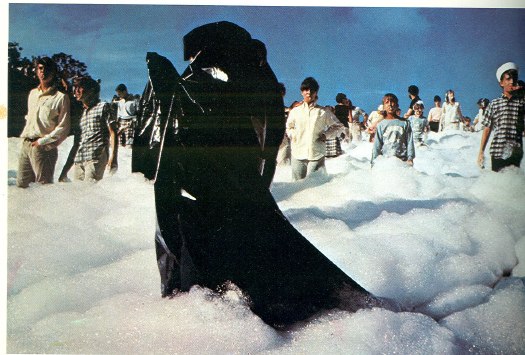
On Sunday, after arranging for three bedsful of nurses to meet the Shelter Island ferry, Kaprow staged two decidedly North-of-the-Highway Happenings in Springs for the kids: a car painting picnic at the auto junkyard, and a foam-filled relay race at the town dump. Alastair Gordon, who was 13 at the time, wrote about participating in the dump event in his awesome book, Spaced Out: Radical Environments of the Psychedelic Sixties, which was excerpted in the Easthampton Star in 2008:
Someone was barking through a megaphone: “Keep moving . . . not too fast . . . don’t look at the cameras. . . .” We were told to move deeper into the sandy pit, slowly, toward a group of people wearing black plastic capes at the bottom of the slope. We wore pink buttons that read “GAS — I’m a Happener” and blew whistles as we marched downward. Stacks of multicolored oil drums were pushed from a ledge, and we were told to roll them back up the slope through the sea of firefighting foam.
I guess I was too young to pick up on the sexual allusion at the time, but the foam felt weirdly comforting as it oozed around my ankles and bubbled up to my waist. Mud stuck to the drums and made them difficult to roll, but we kept pushing because there were men with cameras, and we were going to be on TV.
Though they should have been obvious going in, Kaprow’s problems with Gas seem evident in Gordon’s account: the Happening didn’t just ‘happen,’ it was staged and performed for cameras:
Though nearly everyone, including Hyatt, deemed Gas a success, Kaprow saw it as a reversion to theater. It was a string of “spectacular” Happenings intended more to be seen than enacted, both during the events and on television.
The feedback loop Kaprow loved had been replaced, he found, with
the false feedback of narcissism on a mass-media scale, in which the culture, through the mirror of television, watches itself having a gas.
In the end, the experiment failed because Gas participated in the popular cliches of what Happenings were.
And the avant-garde was inextricably linked with the leisure entertainments of affluent youth. All of which, well, guess what? Whatever Kaprow’s later regrets about it, Gas seems like a peculiar, even unique experiment in corporate-avant-garde collaboration. And the involvement of Hyatt, a member of MoMA’s Junior Council and Dwan in the transform “What I Did On My Vacation’ from arts journalism into public art.
At the very least, it’s a vast improvement over the cliche-ridden, made-for-TV art happenings they’re throwing up these days. [OR. Does good Art-for-TV really just equal failed Art-for-TV + time?]
“What I Did On My Vacation” was shown at Hauser & Wirth’s Kaprow restaging last year, but I can’t find it online. No problem, though, because the National Film Network has a DVD for just $22.
“What I Did On My Vacation” aired on WCBS on Sunday, September 11, 1966.
Vintage coverage from TIME: Gas: Happenings in the Hamptons [time.com]
MoMA, CBS And The Responsive Eye
After watching the first segment at maryandmatt’s blog, I was hooked. Mike Wallace, shooting a 1965 episode of WCBS news show Eye on New York in and about The Museum of Modern Art’s blockbuster exhibition of Op Art, “The Responsive Eye.” [Part 2 and Part 3]
The music, by Specs Powell, a jazz pianist and percussionist who was on staff at CBS, is as stunning as it is jarring. I kept waiting for irony, or Mondo Cane-style sensationalism, or–worse and more likely–the snide philistinism of Wallace’s future 60 Minutes colleague Morley Safer, who infamously sandbagged contemporary art in 1993, resulting in, among other things, Glenn Lowry’s awesome shutout of Safer from covering the Museum’s 1998 Jackson Pollock retrospective. But there was absolutely none. The entire show was serious and straight-up. Part 3, particularly, focuses on arts coverage in the media, and media’s culpability in hyping, distorting, or even fabricating trends for their own purposes. I can almost imagine the pitch meeting for “Eye on New York” as a rebuttal of Time magazine’s dismissive coverage of “Op Art.” “Responsive Eye” curator William Seitz nails it when he kind of laments to Wallace about the impact of superficial arts coverage:
And this, in a sense, does worry me, because it is really, an impact of a–
Well, it’s really the absorption of modern art into modern life. And that’s something we all wanted, but, uh, it may change the character of the art a bit, too.
But should this be at all surprising? CBS’s founder Bill Paley was the Modern’s president at the time. Already a long-time trustee, Paley was tapped by David Rockefeller for the position in 1962, and to succeed him as the first non-family chairman in 1968.
 A couple of folks on Twitter have suggested, rightly, that MoMA should screen this awesome program. As it turns out, they already have been, since 1967. That’s when the Museum’s Junior Council announced the creation of a Television Archive of the Arts, a three year effort which had actually begun identifying, reviewing, and acquiring film and television media about art and artists in 1964. The Archive began when museum officials learned that some of the films and tapes–they don’t say which–were in danger of being destroyed or lost.
A couple of folks on Twitter have suggested, rightly, that MoMA should screen this awesome program. As it turns out, they already have been, since 1967. That’s when the Museum’s Junior Council announced the creation of a Television Archive of the Arts, a three year effort which had actually begun identifying, reviewing, and acquiring film and television media about art and artists in 1964. The Archive began when museum officials learned that some of the films and tapes–they don’t say which–were in danger of being destroyed or lost.
The Archive was to be housed and made available in the new International Study Center, which was under construction. [It’s now demolished, but it stood on the west side of the sculpture garden, about where Taniguchi extended the glass corner of Cesar Pelli’s tower. It’s funny to remember a building and space so clearly, only to realize that not only is it gone, it’s just as likely no one knows what you’re even talking about.]
The PDF archive of MoMA’s press releases is absolutely incredible, by the way. Here are the announcement of the Archive, and the initial checklist. The first 64 programs from ABC, CBS, NBC, National Educational Television, and NYC’s Channel 13 included dozens of artist interviews and documentaries.
One thing that stands out, though, is that only CBS, and only programs like “Eye on New York,” donated their own archive of complete interviews and extra footage. Maybe this was because Gordon Hyatt, the producer, was also on the Junior Council’s committee which put the archive together.
I’m probably long overdue to point this out, but this is really why I’m writing this post: for almost ten years, I was the co-chairman of MoMA’s Junior Associates, which is the successor group to the Junior Council, and I joined the Film Department’s committee after stepping down. And yet so much of this history is completely new to me. So much of the Museum’s activities and programs are professionalized now, but I can still recognize the deeply ingrained culture of, for lack of a better word, “amateur” involvement. It’s really rather remarkable, and it has been for a very long time.
[maryandmatt.net, thanks andy]
CityLAB’s Duck & Cover

And in other Venice Biennale of Architecture exhibition news: cityLAB, Dana Cuff and Roger Sherman’s architecture think tank at UCLA, is also in the US Pavilion show, Workshopping. One of the projects they’re apparently showing is called Duck & Cover, which appears to be a community garden in the form of a giant Google logo visible from Google Earth.
Looks awesome, but wait, are those mirrors up there? Magnifying glasses? Spiral escalators to nowhere? Also, isn’t the G a little self-referential for Google? I’d think they could get ‘er done quicker if they sell the structure’s shape to the highest bidder. Or make it a Q for Quimby.
cityLAB [workshopping.us]
previously: heads up: roof as nth facade
How To Make A Biennale Pavilion Architectural Intervention

MOS, of the PS1’s woolly mammoth carcass MOSes, is one of seven architecture firms and collaboratives included in “Workshopping: an American Model for Architectural Practice,” at the Venice Architecture Biennale. The exhibit is curated by Michael Rooks of the High Museum and Jonathan Solomon of 306090.
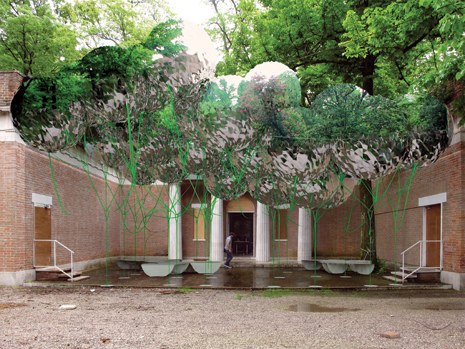
The idea is to creat a canopy of spherical Mylar weather balloons in the courtyard of the US Pavilion. From MOS’s project text:
if you’ve seen the structure, i’m sure you’re wondering, ‘why is it made out of helium balloons, why does it make a canopy, why is there seating, etc… is it referencing other projects? is it analogical? is it utopian? is it micro-? is it urban? is it domestic, what is it? is this even architecture?’ (unfortunately, we can’t answer that last question. this type of project is like diet-architecture, a copy without the calories. it’s got a sort of bitter aftertaste that you might grow accustomed to, or you might not. that’s ok. we like fake architecture.)
we’ve been wondering, what kind of architecture would haruki murakami make? well, when we finally write our text we would definitely tell you that it does, indeed, mean something and it does reference things, but why would you really want to know all of that anyway? do you really think it would make it better? I mean, what about just enjoying this weird artifice, this fake social space? hey, it wiggles. look at this strange alternate environment made of reflections and repetitions. enjoy the visual noise. have you ever seen N.A.S.A.’s echo project? google it. what can we say, we just love the aesthetics of radar reflectors and inflated satellites. they are of another reality. seriously, even if we wanted to fully explain it to you at this very moment, we couldn’t. even though we’re trying not to be, we’re only human. also, they need this text before we’ve finished the design. did we mention that we are working with the son of andy warhol’s ‘silver clouds’ fabricator? we’re very excited about this. he lives in duluth. [emphasis added because, well]
So just Google, aesthetics, and a flip three degrees of Andy Warhol reference and voila, instant pavilion! I can’t wait to see what their actual text is. The exhibition opens Thursday.
MOS, Instant Untitled [designboom, thanks john]
Workshopping.us [workshopping.us]
The Dictates Of Our Own Conscience
“11. We claim the privilege of worshiping Almighty God according to the dictates of our own conscience and allow all men the same privilege, let them worship how, where, or what they may.”
– Joseph Smith, The Articles of Faith, “Thirteen statements describing the fundamental beliefs of members of The Church of Jesus Christ of Latter-day Saints.”
